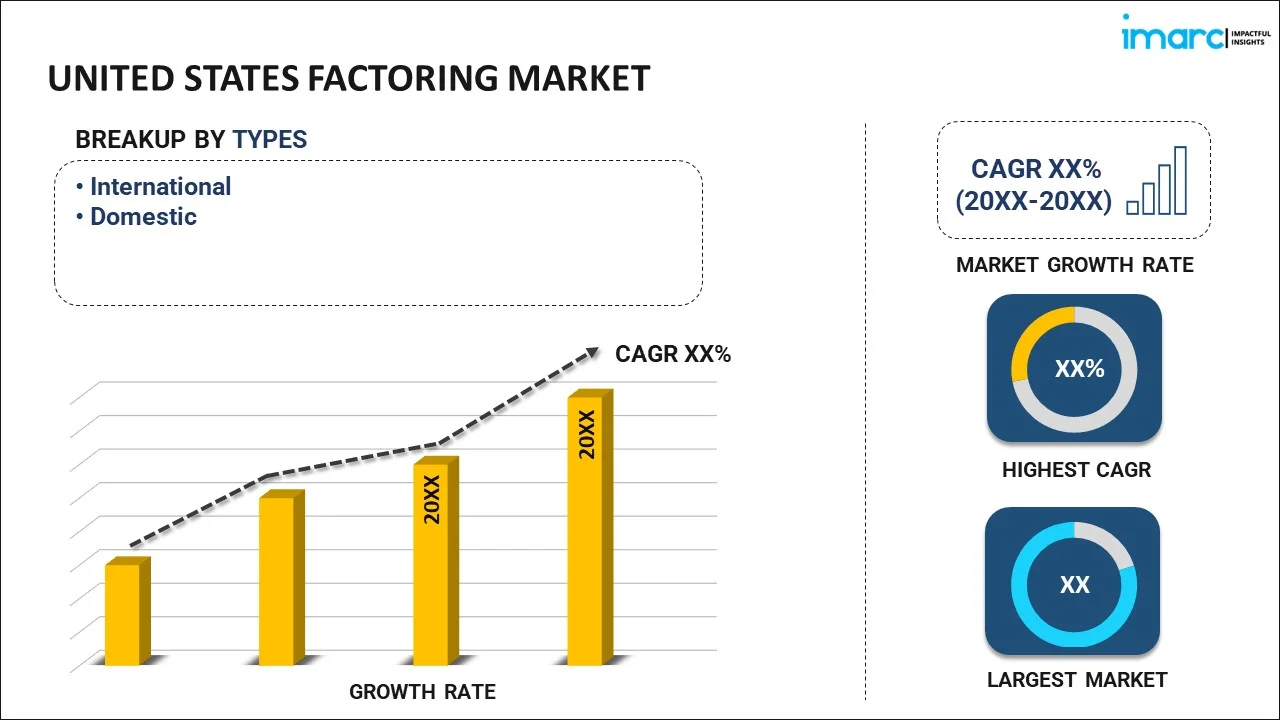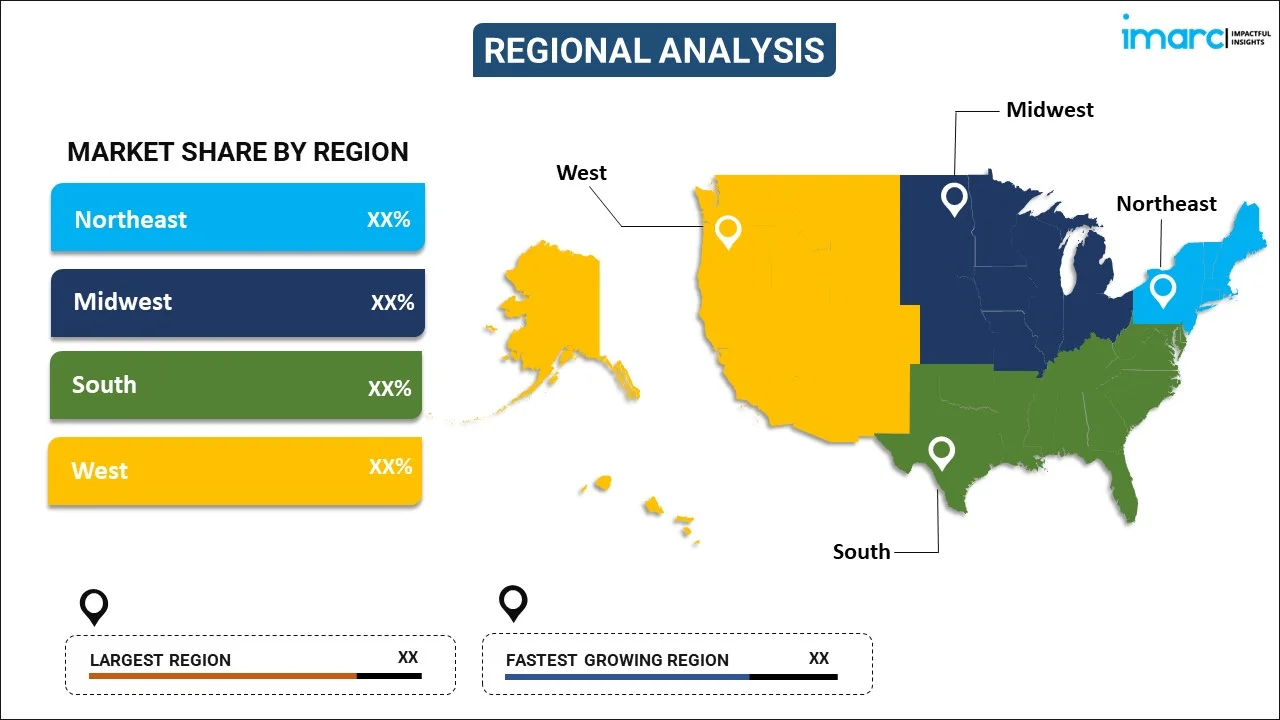
United States Factoring Market Report by Type (International, Domestic), Organization Size (Small and Medium-sized Enterprises, Large Enterprises), Application (Transportation, Healthcare, Construction, Manufacturing, and Others), and Region 2025-2033
Market Overview:
United States factoring market size reached USD 1,006.5 Billion in 2024. Looking forward, IMARC Group expects the market to reach USD 1,962.2 Billion by 2033, exhibiting a growth rate (CAGR) of 7.70% during 2025-2033. The increasing demand for automation, digital platforms, and streamlined processes that can make factoring more efficient and accessible, is driving the market.
|
Report Attribute
|
Key Statistics
|
|---|---|
|
Base Year
|
2024
|
|
Forecast Years
|
2025-2033
|
|
Historical Years
|
2019-2024
|
|
Market Size in 2024
|
USD 1,006.5 Billion |
|
Market Forecast in 2033
|
USD 1,962.2 Billion |
| Market Growth Rate 2025-2033 | 7.70% |
United States Factoring Market Analysis:
- Major Market Drivers: The United States factoring market growth is primarily driven by increasing demand for alternative financing solutions among small and medium enterprises. Rising automation requirements, digital platform adoption, and streamlined processes are enhancing factoring accessibility and efficiency across various industries, supporting sustained market expansion.
- Key Market Trends: Digital transformation initiatives are revolutionizing the market share landscape. Fintech integration, artificial intelligence (AI) implementation, and blockchain technology adoption are streamlining operations, reducing processing times, and improving risk assessment capabilities, creating competitive advantages for market participants.
- Competitive Landscape: The competitive environment within the United States factoring market analysis reveals a fragmented structure with numerous regional and national players. Market participants are focusing on technological innovations, strategic partnerships, and enhanced customer service offerings to maintain competitive positioning.
- Challenges and Opportunities: Regulatory compliance complexities present challenges while growing SME financing needs create significant opportunities. The factoring sector benefits from economic recovery trends, increasing trade volumes, and expanding digital adoption rates across target customer segments.
Factoring is a mathematical process that involves breaking down a number or algebraic expression into its constituent factors, which are the numbers or expressions that multiply together to produce the original number or expression. In the context of numbers, factoring involves finding the prime numbers that multiply to give the original number. This process is essential in number theory and plays a crucial role in various mathematical and cryptographic algorithms. In algebra, factoring is employed to simplify expressions, solve equations, and understand the structure of polynomials. It is a fundamental skill in algebraic manipulation and problem-solving. Factoring is particularly useful in solving quadratic equations, where expressions are broken down into linear factors. Additionally, factoring is a key concept in algebraic fractions, allowing for simplification and cancellation of common factors. Overall, factoring is a versatile and powerful tool in mathematics, with applications ranging from elementary arithmetic to advanced algebra and beyond.
United States Factoring Market Trends:
Digital Platform Integration in Factoring Services
The United States factoring industry is going through tremendous changes with digital platform integration. Cutting-edge fintech technology is overhauling legacy factoring operations, making it possible to process invoices in real-time, assess credit automatically, and process documents with ease. Such technological innovations lower the cost of operations, increase the speed of processing, and enhance customer experience dramatically. Online platforms allow for easy integration with enterprise resource planning systems, making factoring services accessible to businesses in a more effective manner. Cloud solutions offer scalable infrastructure for both small businesses and big corporations. ML algorithms improve risk assessment accuracy, minimizing default rates as well as profitability margins. The integration of AI provides predictive analytics, which enables factoring companies to identify anticipated risks and opportunities in advance. Mobile applications provide convenient access to factoring services, allowing businesses to manage their accounts remotely and receive instant notifications about transaction status and funding availability.
Regulatory Framework Evolution and Compliance Enhancement
Regulatory landscape evolution significantly impacts United States factoring market share across the region. Government initiatives promoting alternative financing solutions create favorable conditions for market expansion, while enhanced compliance requirements ensure consumer protection and market stability. Federal and state law sets transparent guidelines for factoring businesses, ensuring transparency and ethical business conduct. Regulatory agencies target preventing predatory lending instead of encouraging genuine factoring businesses that facilitate business expansion. Better reporting requirements enhance market surveillance, allowing regulators to track market trends and spot potential threats more effectively. Technology compliance systems assist factoring businesses in upholding regulation compliance while minimizing administrative activities and operational expenses. Industry groups work with regulatory authorities to create best practices and standards that ensure ethical business practices and market integrity across the factoring value chain.
Development of Sector-Specific Factoring Solutions
Specialized factoring solutions specific to a given industry's needs and operating nature are being developed by market participants. Healthcare factoring involves special billing cycles, regulatory compliance requirements, and payment processing issues specific to medical service providers. Transportation factoring services provide for fluctuations in fuel prices, seasonal changes in demand, and longer payment terms characteristic of logistics operations. Construction factoring solutions meet project-based payment schemes, material price volatility, and contractor-subcontractor payment arrangements. Manufacturing factoring solutions meet supply chain finance requirements, inventory management needs, and export-import transaction complexities. Tech firms take advantage of factoring solutions that cater to subscription-based revenue streams, intellectual property management issues, and fast-scaling demands. These customized strategies boost service efficiency, enhance customer satisfaction, and generate competitive differentiation opportunities for factoring service providers in various market segments.
United States Factoring Market Segmentation:
IMARC Group provides an analysis of the key trends in each segment of the market, along with forecasts at the country level for 2025-2033. Our report has categorized the market based on type, organization size, and application.
Type Insights:

To get more information on this market, Request Sample
- International
- Domestic
The report has provided a detailed breakup and analysis of the market based on the type. This includes international and domestic.
Organization Size Insights:
- Small and Medium-sized Enterprises
- Large Enterprises
A detailed breakup and analysis of the market based on the organization size have also been provided in the report. This includes small and medium-sized enterprises and large enterprises.
Application Insights:
- Transportation
- Healthcare
- Construction
- Manufacturing
- Others
The report has provided a detailed breakup and analysis of the market based on the application. This includes transportation, healthcare, construction, manufacturing, and others.
Regional Insights:

- Northeast
- Midwest
- South
- West
The report has also provided a comprehensive analysis of all the major regional markets, which include Northeast, Midwest, South, and West.
Competitive Landscape:
The market research report has also provided a comprehensive analysis of the competitive landscape in the market. Competitive analysis such as market structure, key player positioning, top winning strategies, competitive dashboard, and company evaluation quadrant has been covered in the report. Also, detailed profiles of all major companies have been provided.
United States Factoring Market Report Coverage:
| Report Features | Details |
|---|---|
| Base Year of the Analysis | 2024 |
| Historical Period | 2019-2024 |
| Forecast Period | 2025-2033 |
| Units | Billion USD |
| Scope of the Report | Exploration of Historical and Forecast Trends, Industry Catalysts and Challenges, Segment-Wise Historical and Predictive Market Assessment:
|
| Types Covered | International, Domestic |
| Organization Sizes Covered | Small and Medium-sized Enterprises, Large Enterprises |
| Applications Covered | Transportation, Healthcare, Construction, Manufacturing, Others |
| Regions Covered | Northeast, Midwest, South, West |
| Customization Scope | 10% Free Customization |
| Post-Sale Analyst Support | 10-12 Weeks |
| Delivery Format | PDF and Excel through Email (We can also provide the editable version of the report in PPT/Word format on special request) |
Key Benefits for Stakeholders:
- IMARC’s industry report offers a comprehensive quantitative analysis of various market segments, historical and current market trends, market forecasts, and dynamics of the United States factoring market from 2019-2033.
- The research report provides the latest information on the market drivers, challenges, and opportunities in the United States factoring market.
- Porter's five forces analysis assist stakeholders in assessing the impact of new entrants, competitive rivalry, supplier power, buyer power, and the threat of substitution. It helps stakeholders to analyze the level of competition within the United States factoring industry and its attractiveness.
- Competitive landscape allows stakeholders to understand their competitive environment and provides an insight into the current positions of key players in the market.
Key Questions Answered in This Report
The factoring market in the United States was valued at USD 1,006.5 Billion in 2024.
The United States factoring market is projected to exhibit a CAGR of 7.70% during 2025-2033, reaching a value of USD 1,962.2 Billion by 2033.
The market is driven by increasing demand for automation, digital platforms, and streamlined processes that enhance factoring efficiency and accessibility. Alternative financing needs among SMEs, technological advancements, and economic recovery trends are primary growth catalysts supporting market expansion.
Need more help?
- Speak to our experienced analysts for insights on the current market scenarios.
- Include additional segments and countries to customize the report as per your requirement.
- Gain an unparalleled competitive advantage in your domain by understanding how to utilize the report and positively impacting your operations and revenue.
- For further assistance, please connect with our analysts.
 Request Customization
Request Customization
 Speak to an Analyst
Speak to an Analyst
 Request Brochure
Request Brochure
 Inquire Before Buying
Inquire Before Buying




.webp)




.webp)












